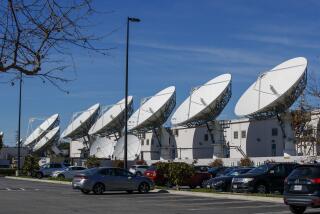The Dish on DirecPCâs Satellite Receiver Unit
Iâve found a way to connect to the Internet that is, literally if not figuratively, out of this world. The DirecPC satellite dish on my roof lets me download data at up to 400 kilobits per second. Thatâs nearly 14 times faster than a standard 28.8-Kbps modem and four times faster than the integrated system digital network, or ISDN, the most affordable alternative to modem connections currently offered by Pacific Bell and other phone companies.
Thatâs the good news. The bad news is that the system is expensive, requires a relatively elaborate installation and configuration and, in the end, doesnât necessarily speed up your access to the World Wide Web.
Hughes Communications, proprietor of the DirecPC system, just cut its prices last week--to $399 retail (including a $100 rebate) for the dish, PC card and software. Then there is a $49.95 one-time activation fee. The monthly charges start at $9.95, but that is for a limited account that also requires you to pay to download data. The âMoon Surferâ account, which costs $39.95, gives you unlimited access nights and weekends. If you want unlimited access during the day, youâll have to pay $129 a month for the âSun Surferâ plan.
In addition to these charges, you also need to be signed up with an Internet service provider, or ISP, which typically costs about $20 a month.
You can use any ISP other than online services such as Prodigy or America Online (though you can use Prodigy Internet or the Microsoft Network). The reason you need an ISP is because DirecPC is a one-way system. The satellite sends data to your PC, but you need to use a standard modem and a regular ISP to send data or commands to the DirecPC network.
The data you send flows at the speed of your modem--typically 28 kilobytes per second. The fact that the satellite is only one-way isnât as bad as it might seem. Most users send relatively little data compared with what they receive.
If you wish to view a Web site, for example, you would send the Web address to the system via the modem, but the siteâs text and graphics would rush back to you via the satellite. Since the address is typically only a few bytes, that takes almost no time, even if you have a slow modem. The data from the site itself takes up far more time, especially if itâs laden with graphics. Those who do send (upload) a lot of data, including people who need to update their own Web sites, will get no advantage from the satellite system while they are uploading.
The system I tested came with a 21-inch satellite dish thatâs similar to the ones used for DirecPCâs sibling, the DirecTV television service. (Hughes unveiled last week a dish that can be used for both data and television.)
In addition to the dish, you get a 16-bit card that plugs into an ISA port of a desktop PC. That eliminates Macs, notebook PCs and any other machines that donât have available slots. You also get software and 100 feet of coaxial cable to connect the dish to the PC.
Positioning the dish can be a little tricky--it has to be aimed directly at the appropriate satellite. The companyâs Web site (https://www.direcpc.com) says that âitâs easy to install the DirecPC satellite dish and ISA card,â but I wasnât about to climb up to my roof to find out. (You can install the dish on the ground or in a window only if the location has direct line-of-sight to the satellite.)
So, I accepted their offer to have it installed professionally. Customers will pay between $149 and $199 for professional help, or $89 per hour plus materials if custom installation is required.
*
Installing the software was relatively easy, but getting it to work required having to type in a seemingly endless series of Internet Protocol addresses and other gobbledygook. It reminded me of what all Internet users had to go through in the dark old days--about a year ago--before companies such as Microsoft Network, Prodigy Internet and Spry started offering software that configured the Internet for you. (DirecPC says the configuration complexities have now been solved.)
Once installed, the system is easy to use. Clicking on a single icon brings up the satellite connection and dials your ISP.
I used the system to download a 1.1-megabyte file from a remote server via the Internet and was blown away at how quickly it went. DirecPC did the job in 20 seconds, compared with 422 seconds using a standard 28.8 modem. The satellite system downloaded the file five times faster than my 115-Kbps ISDN connection.
*
But Iâm afraid I canât report the same dazzling results when it comes to Web surfing. I set up two nearly identical PCs side by side. One was connected to the Net at 28.8 Kbps and the other with DirecPC. In most cases, the satellite system displayed Web pages a bit faster than the one with a modem, but not by much.
In some cases, the modem-equipped PC was faster, especially with sites that donât have a great deal of graphics. Thatâs because there are several factors that determine how long it takes to reach and display a Web site. These include the speed of your PC, your connection to your Internet service provider, your ISPâs connection to the Internet itself, traffic on the Internet and the speed and current traffic conditions on the site youâre visiting.
When it comes to performance, these other factors can often have a greater impact than the actual speed at which youâre connected. I noticed no appreciable difference in Web performance between the satellite system and my ISDN connection. Because most e-mail messages are fairly short, I didnât usually notice much difference there except when receiving large files.
I did notice much better performance when using the satellite system to play RealAudio (https://www.realaudio.com) and to view sites with video and lots of graphics. Thatâs because these sites transmit relatively large amounts of data, which is where DirecPC starts to shine. That could eventually be a big advantage as an increasing number of information providers start using the Internet for full-motion video and other multimedia presentations.
But alluring as its promise may be, DirecPC for now doesnât offer spectacular advantages for normal Web surfing, even though it does carry a spectacular price. And if youâre thinking about a long-term investment, consider that in the future there will be other options for high-speed Net access, such as cable modems. So unless you have really special needs or an unlimited budget, you probably wonât want DirecPC in your orbit.
*
Lawrence J. Magid can be reached by e-mail at [email protected]. His World Wide Web page is at https://www.larrysworld.com





